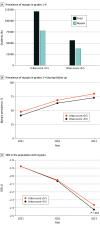Urban Living Environment and Myopia in Children
- PMID: 38064211
- PMCID: PMC10709769
- DOI: 10.1001/jamanetworkopen.2023.46999
Urban Living Environment and Myopia in Children
Abstract
Importance: The global prevalence of myopia has shown a steady increase over recent decades, with urban areas seemingly experiencing a more significant impact.
Objective: To assess the association between urbanization and the prevalence, incidence, progression, and severity of myopia.
Design, setting, and participants: This cohort study included students in grades 1 to 6 in Tianjin, China, who underwent 3 vision examinations conducted over a 2-year period, from March 1, 2021, to March 31, 2023. Participants from grades 1 to 4 completed the 2-year follow-up.
Exposures: Urban living environment.
Main outcomes and measures: The association of urbanization with the incidence, progression, prevalence, and severity of myopia. To quantify urbanization, an urban score was constructed using satellite data and an iterative exploratory factor analysis.
Results: Of 177 894 students (51.7% male; mean [SD] age, 10.27 [1.75] years) included in the study, 137 087 students (52.3% male; mean [SD] age, 8.97 [1.21] years) were followed up for 2 years. A positive association was identified between myopia incidence and urbanization. Specifically, each 1-unit increment in the urban score was associated with an increased risk of myopia over a 1-year period (odds ratio [OR], 1.09; 95% CI, 1.01-1.15; P = .02) and a 2-year period (OR, 1.53; 95% CI, 1.50-1.57; P < .001). Conversely, each 1-unit increase in the urban score was associated with a significant decrease in myopia progression at 1 year (OR, 0.84; 95% CI, 0.82-0.86; P < .001) and 2 years (OR, 0.73; 95% CI, 0.70-0.75, P < .001). In a cross-sectional data analysis, the urban score was positively associated with myopia prevalence (OR, 1.62; 95% CI, 1.08-2.42; P = .02) and negatively associated with myopia severity, as indicated by spherical equivalent refraction (OR, 1.46; 95% CI, 1.07-1.99; P = .02).
Conclusions and relevance: This study exploring urban living environments and myopia revealed dual associations of urban living with both the incidence and the progression of myopia. The observed patterns emphasize the urgency of promptly implementing myopia control strategies in less urbanized regions, where myopia progression may be accentuated.



